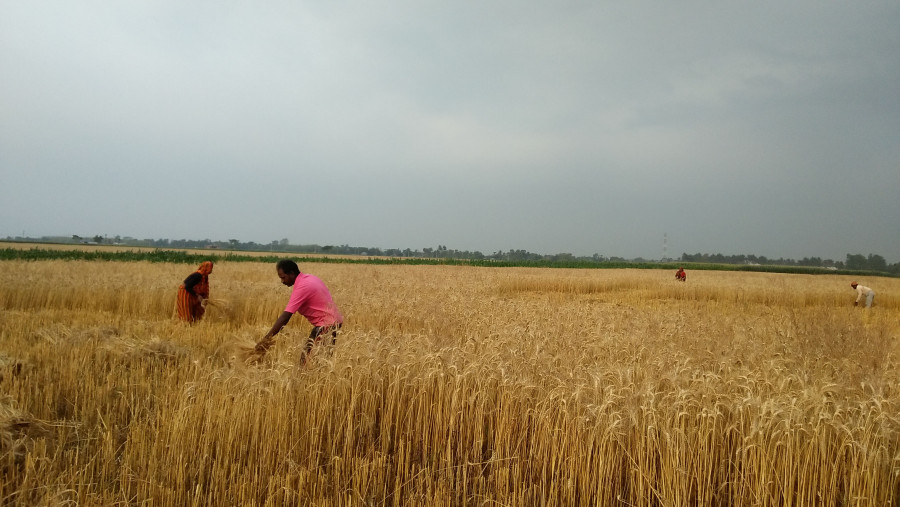Money
Wheat harvest likely to be less due to long dry winter
The drought is expected to have lessened the yield by 8 percent to 2.09 million tonnes, officials said.
Sangam Prasain
This year's wheat harvest is likely to be smaller after four straight years of bumper crops due to a long dry winter.
Nepali farmers brought in their wheat harvest in March. The drought is expected to have lessened the yield by 8 percent to 2.09 million tonnes, according to the Ministry of Agriculture and Livestock Development.
The drop in cereal production may put pressure on the country’s weakened economy which saw a negative growth of 1.99 percent in the last fiscal year ended mid-July, largely due to the Covid-19 pandemic.
The sharp reduction in output, of around 171,000 tonnes, is due to a long spell of winter drought in key producing areas, mostly in the far western region, the ministry said. This translates to a loss of more than Rs5.3 billion.
Computed on the basis of the minimum support price of Rs31.11 per kg set by the government for this fiscal year, the wheat crop’s value comes to Rs68 billion.
Wheat is Nepal's third major cereal crop after rice and maize.
“The reduced output is mainly due to a long spell of winter drought,” said Ram Krishna Regmi, chief statistician at the ministry. “Despite the sharp drop, it is still the second highest harvest in history.”
Production was down chiefly in Kailali and Kanchanpur including some hills districts of Karnali, he said. “The Karnali region may become food-insecure due to the drop in winter crops like wheat and barley, although they don’t account for a large share of national production,” he said.
During the current fiscal year 2020-21, Nepal’s paddy production reached a record high for the fourth straight year due to good monsoon rains and an abundant supply of farmhands, even though a severe shortage of chemical fertiliser during transplantation and top dressing had caused distress among farmers.
The Ministry of Agriculture and Livestock Development’s summer crop harvest statistics show that Nepal recorded a paddy harvest of 5.62 million tonnes, up by a marginal 1.28 percent compared to the last fiscal year.
Surplus monsoon rains this fiscal year, and an ample labour supply due to virus lockdowns which sent back hordes of migrant workers to their villages helped South Asian countries, including Nepal, gather bumper harvests.
The monsoon started on June 12, 2020, two days after its usual entry, and remained for an additional three weeks, which supported planting activities and benefited crop germination.
According to the Meteorological Forecasting Division, the summer monsoon withdrew from Nepal on October 16, making it one of the longest rainy seasons. The normal date of withdrawal of the monsoon from Nepal is September 23.
“But the winter drought prevailed for a long time,” said Regmi. “The country may see less wheat, but the record paddy harvest may compensate for the losses. The overall cereal crops requirement will be at the 2019-20 level.”
But food security concerns remain for the population, mostly concentrated in the remote northern parts of the far western and mid‑western mountainous regions, said Regmi.
“This region generally has low agricultural productivity and a high out-migration rate,” he said, adding that the Covid-19 pandemic also affected the remittance earning in this region where the vast majority of people travel to India to work as seasonal workers.
Nepal witnessed a harsh drought last winter with 75 percent less rain than the normal average for the season, according to the Department of Hydrology and Meteorology.
During the three winter months of December, January and February, Nepal would, on average, receive 60.4 mm of rainfall. But this season, only 15.4 mm of rain fell in the country, official figures showed.
Some places like Bhairahawa saw not a drop of rain.
Few areas get irrigation water in the winter, and Nepal has been almost totally dependent on the skies to water the winter crops. Winter drought has been recurring in the country.
Nepal witnessed a record wheat output of 1.97 million tonnes in 2014-15. Production plunged 12.1 percent to a six-year low of 1.73 million tonnes in 2015-16 due to winter drought.
Harvests jumped 6 percent in 2016-17, reaching 1.84 million tonnes. The country’s wheat production stood at a record 1.94 million tonnes in 2017-18 despite a prolonged winter drought.
In 2018-19, the output swelled to 2.08 million tonnes; and in 2019-20, the harvest reached an all-time high of 2.18 million tonnes, according to the ministry's statistics.
Annual wheat output
Year Output (in tonnes)
2020-21 2.09 million
2019-20 2.18 million
2018-19 2.08 million
2017-18 1.94 million
2016-17 1.84 million
2015-16 1.73 million
2014-15 1.97 million
2013-14 1.88 million
2012-13 1.88 million
2011-12 1.84 million
(Source: Ministry of Agriculture and Livestock Development)




 8.12°C Kathmandu
8.12°C Kathmandu














